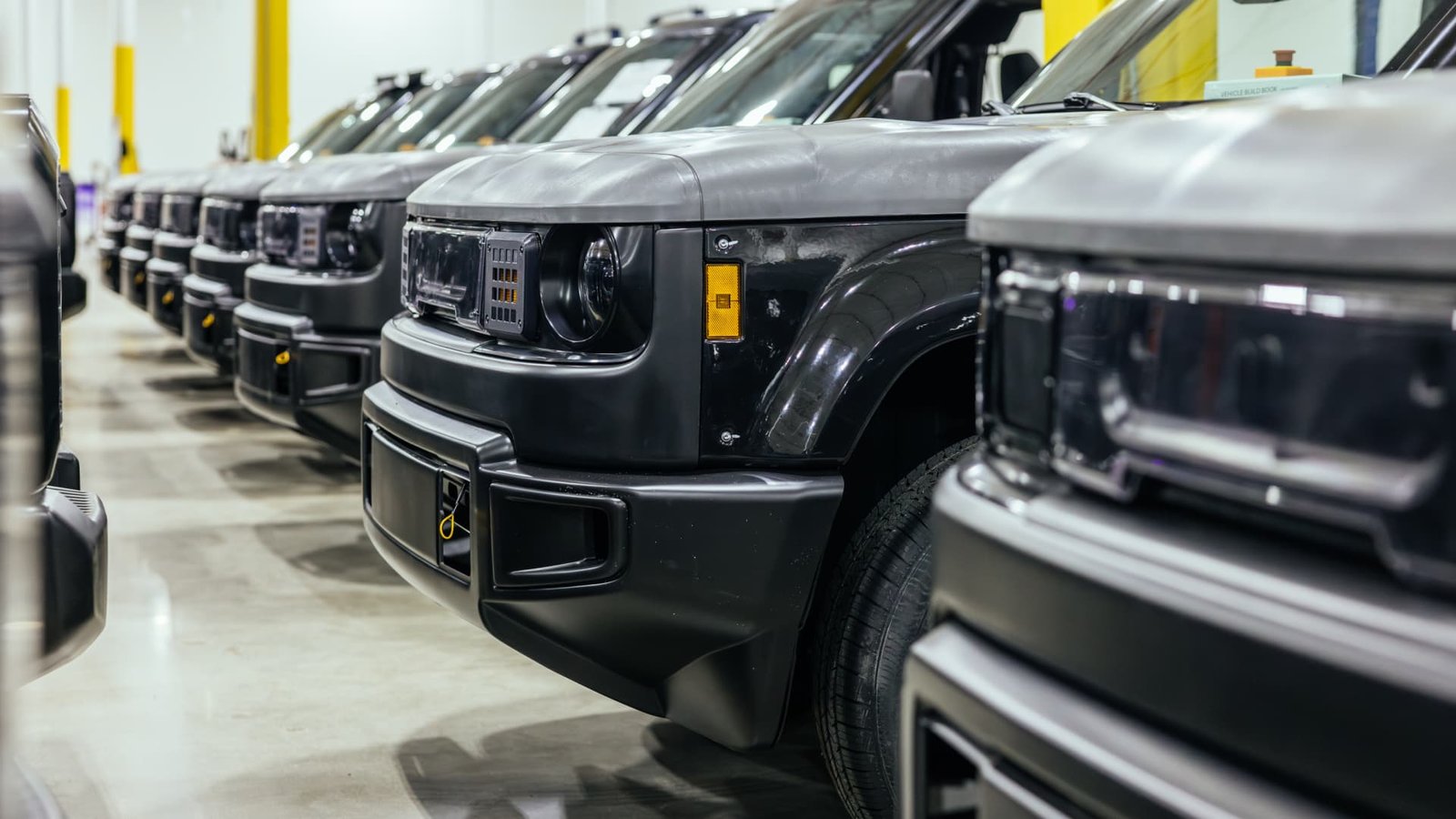Slate Auto electric vehicles inside the startup’s beta production facility in Lake Orion Township, Michigan.
Slate Auto
LAKE ORION TOWNSHIP, Mich. — In a nondescript supplier park in suburban Detroit, an electric vehicle startup backed by Amazon founder Jeff Bezos is building what it hopes will be America’s newest automaker.
The facility is filled with dozens of prototypes, crash-tested vehicles, a crude lab vehicle skeleton adorned with wires and, most importantly, a busy “beta” assembly line that has been building electric vehicles since December for the startup, Slate Auto.
Slate is using the location — a stone’s throw away from a massive General Motors assembly plant — to produce more than 70 vehicles for internal testing, certification and everything else a company needs to prepare to produce and sell vehicles in the United States.
The beta production line features roughly a dozen labeled stations for things such as the vehicle’s doors, tailgate and front ends that sit in bins or on surface areas made out of wood and steel parts.
Employees move back and forth between the bins, tables and assembly line as songs such as Whitney Houston’s “Saving All My Love for You” and Pat Benatar’s “Love is a Battlefield” echo throughout the lively facility.
The largely hand-built vehicles being made are bare-bones, two-seat, two-door electric pickup trucks that can also be converted to different body styles of SUVs, such as a five-seat fastback or into a squared-off look like a Jeep Wrangler.
A Slate Auto employee walks into the startup’s “beta” manufacturing facility on May 16 in Lake Orion Township, Michigan.
Michael Wayland / CNBC
The vehicles have injected-molded composite exteriors, crank windows, no infotainment systems and a litany of do-it yourself options. The plan is for every vehicle coming off the line to be the same to reduce complexity, before adding any additional features or different covers/tops.
Auto executives have tossed around the idea for such a modular, stripped-down vehicle amid the rise of connectivity and affordability concerns, but so far the challenges have outweighed the potential opportunities, or companies have struggled to keep prices down.
Slate believes it can succeed where others have failed through simplified manufacturing and lower costs – two areas where other EV startups have failed in recent years.
“This one’s going to be different for a number of reasons,” Eric Keipper, an auto veteran and Slate’s head of engineering, told CNBC after a tour of the company’s manufacturing facility. “We took the back-to-basics, only-the-essentials approach, and, really, we’re building a completely new category of product.”
Slate exited its “stealth mode” in late April by revealing its first vehicles — several two-door electric pickup trucks and converted SUVs — that it expects to begin deliveries of by the end of next year. It’s in the process of building out a full production facility at a former printing plant in Warsaw, Indiana, where it expects to have capacity for up to 150,000 vehicles a year.
It’s a daunting timeframe even for an established automaker, let alone a new startup that’s establishing its supply chains, production processes and workforce, among other things. Hand-building vehicles at a small facility is one thing; mass producing them is another.
“We’ve put together a really solid plan, and we’re working to achieve the plan,” Slate CEO Chris Barman told CNBC. “It doesn’t mean that we follow the plan exactly. We gotta pivot when different information comes, but we understand what we’ve got to do to ultimately get to the goal of having vehicles that meet all of our requirements.”
The Slate Truck.
Courtesy: Slate Auto
Slate revealed its unnamed vehicle (the company is telling customers to name it themselves) to notable fanfare, attracting more than 100,000 reservations that required a $50 deposit. For other companies, however, vehicles reservations have fallen significantly short of actual sales.
The company said it is conducting a Series C round of financing after raising $700 million in its first two rounds of financing. TechCrunch first reported the Series A round in 2023 raised $111 million from 16 investors, including Bezos.
Other EV startups have needed significantly more funding and have quickly blown through billions of dollars annually attempting to get a vehicle into production. But Slate believes it can be far less capital intense thanks to the engineering and production of the vehicle.
“We are building the affordable vehicle that has long been promised but never been delivered,” Barman said during the April 24 debut. “But with a twist, it’s a vehicle people are actually going to love and be proud to own.”
The company declined to discuss future targets such as sales and profitability, as well as expected capital requirements, other than that it plans to invest hundreds of millions of dollars in its Indiana plant.
Stellantis predecessor Fiat Chrysler, among other companies — met nearly three years ago to discuss the vehicle and Slate’s business plan as the first employees of the startup.
“It started with a blank slate,” said Keipper. “The CEO and I sat together on the fifth of July in 2022 and looked at a blank whiteboard, and I filled it. I said, ‘Here’s the plan. Let’s do this.'”
Slate Auto CEO, Chris Barman.
Courtesy: Slate
During the reveal, the company positioned itself and its vehicle as a “a radically simple, radically affordable, radically personalizable car.”
The vehicle — which has a targeted starting price of under $20,000 with an up to $7,500 EV credit — features many “off the shelf” parts from suppliers, lowering costs. Its body also is exclusively injected molded composite instead of steel or aluminum, bringing down cost and weight.
It does not feature any “connectivity” such as a modem or large screens, just a small driver information screen. Instead of a center infotainment system, drivers can use their own devices such as a smartphone or tablet for navigation and music. Speakers also are optional.
The exteriors of the Slate vehicles also won’t be painted. The company says it was engineered to be wrapped with a vinyl film, eliminating the need for a costly paint shop — a massive investment for automakers.
The basis for the company is for consumers to be able to easily change the vehicle themselves or add whatever they’d like to it after purchase through the removal or addition of bolts. The company plans to offer some services such as the vehicle wrapping, but customers aren’t required to do those things through Slate and can purchase add-ons later.
Slate says the truck — about the length of a two-door Ford Bronco — features roughly a fifth less parts compared to a typical vehicle, including only 500 to 700 “end items,” or parts, for final assembly. That compares with a Slate estimate of 2,500-end item parts for other competitors and thousands of more overall pieces.
“Fundamentally, there’s no new technology because technology costs money to develop,” said Jamie Standring, formerly with Karma Automotive and Stellantis/Fiat Chrysler, standing by the beta assembly line.
Standring said the initial idea was to have the vehicle’s frame that everything is built upon be bolted together – almost like an erector set – to remove the need for a full body shop, much like it’s attempting to not use a paint shop. But the drawbacks eventually outweighed the benefits, he said.
The Slate truck is expected to ship with a standard 52.7-kWh battery with an estimated range of around 150 miles, or a 84.3-kWh pack with a target of 240 miles of range. Its battery supplier is SK On, according to the company. Its top speed is only 90 miles per hour.
“I’m really proud of the team for how they really thought out of the box,” Barman said. “We’ll have kits, and we’re doing it in a way that’s lean as well, but we want to offer people many choices.”
company’s website, there are 11 categories for customers to customize with a combined 160 options, excluding customizable exterior colors for wraps. That’s a lot of options – ranging from dozens of decals to lighting, audio and tires and wheels – for a customer to pick and a company to store and offer.
Slate executives say the point of the customization is for customers to be able to make the vehicle their own and easily upgrade or change it when they’d like, but auto analysts see it as one of many potential problem areas.



